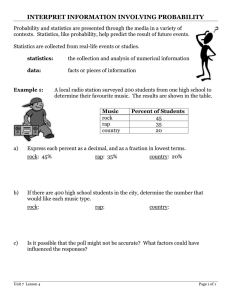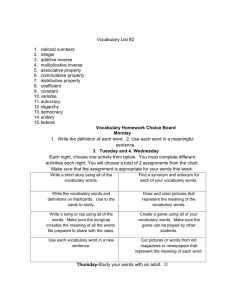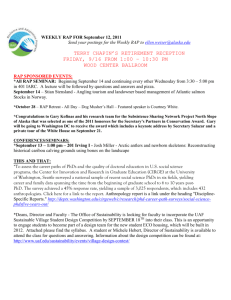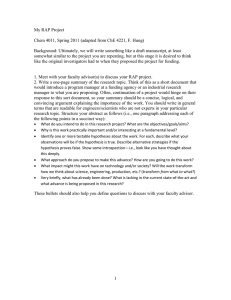RAP in Flexible Pavement: Assessment Study
advertisement
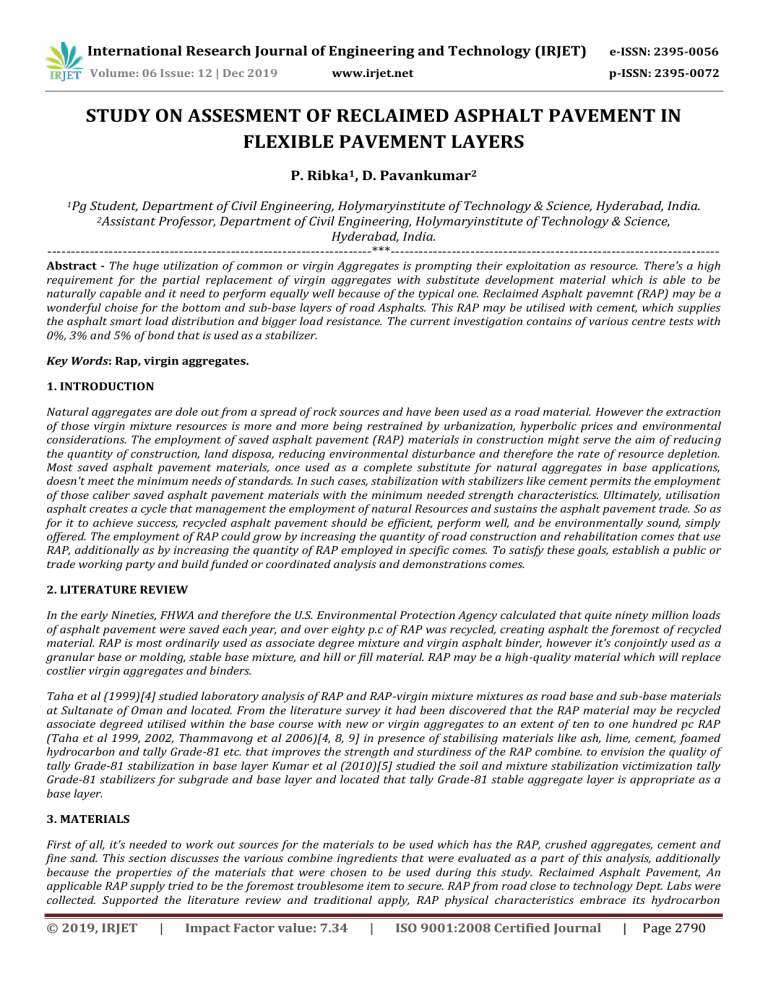
International Research Journal of Engineering and Technology (IRJET) e-ISSN: 2395-0056 Volume: 06 Issue: 12 | Dec 2019 p-ISSN: 2395-0072 www.irjet.net STUDY ON ASSESMENT OF RECLAIMED ASPHALT PAVEMENT IN FLEXIBLE PAVEMENT LAYERS P. Ribka1, D. Pavankumar2 1Pg Student, Department of Civil Engineering, Holymaryinstitute of Technology & Science, Hyderabad, India. 2Assistant Professor, Department of Civil Engineering, Holymaryinstitute of Technology & Science, Hyderabad, India. ---------------------------------------------------------------------***---------------------------------------------------------------------Abstract - The huge utilization of common or virgin Aggregates is prompting their exploitation as resource. There's a high requirement for the partial replacement of virgin aggregates with substitute development material which is able to be naturally capable and it need to perform equally well because of the typical one. Reclaimed Asphalt pavemnt (RAP) may be a wonderful choise for the bottom and sub-base layers of road Asphalts. This RAP may be utilised with cement, which supplies the asphalt smart load distribution and bigger load resistance. The current investigation contains of various centre tests with 0%, 3% and 5% of bond that is used as a stabilizer. Key Words: Rap, virgin aggregates. 1. INTRODUCTION Natural aggregates are dole out from a spread of rock sources and have been used as a road material. However the extraction of those virgin mixture resources is more and more being restrained by urbanization, hyperbolic prices and environmental considerations. The employment of saved asphalt pavement (RAP) materials in construction might serve the aim of reducing the quantity of construction, land disposa, reducing environmental disturbance and therefore the rate of resource depletion. Most saved asphalt pavement materials, once used as a complete substitute for natural aggregates in base applications, doesn't meet the minimum needs of standards. In such cases, stabilization with stabilizers like cement permits the employment of those caliber saved asphalt pavement materials with the minimum needed strength characteristics. Ultimately, utilisation asphalt creates a cycle that management the employment of natural Resources and sustains the asphalt pavement trade. So as for it to achieve success, recycled asphalt pavement should be efficient, perform well, and be environmentally sound, simply offered. The employment of RAP could grow by increasing the quantity of road construction and rehabilitation comes that use RAP, additionally as by increasing the quantity of RAP employed in specific comes. To satisfy these goals, establish a public or trade working party and build funded or coordinated analysis and demonstrations comes. 2. LITERATURE REVIEW In the early Nineties, FHWA and therefore the U.S. Environmental Protection Agency calculated that quite ninety million loads of asphalt pavement were saved each year, and over eighty p.c of RAP was recycled, creating asphalt the foremost of recycled material. RAP is most ordinarily used as associate degree mixture and virgin asphalt binder, however it's conjointly used as a granular base or molding, stable base mixture, and hill or fill material. RAP may be a high-quality material which will replace costlier virgin aggregates and binders. Taha et al (1999)[4] studied laboratory analysis of RAP and RAP-virgin mixture mixtures as road base and sub-base materials at Sultanate of Oman and located. From the literature survey it had been discovered that the RAP material may be recycled associate degreed utilised within the base course with new or virgin aggregates to an extent of ten to one hundred pc RAP (Taha et al 1999, 2002, Thammavong et al 2006)[4, 8, 9] in presence of stabilising materials like ash, lime, cement, foamed hydrocarbon and tally Grade-81 etc. that improves the strength and sturdiness of the RAP combine. to envision the quality of tally Grade-81 stabilization in base layer Kumar et al (2010)[5] studied the soil and mixture stabilization victimization tally Grade-81 stabilizers for subgrade and base layer and located that tally Grade-81 stable aggregate layer is appropriate as a base layer. 3. MATERIALS First of all, it's needed to work out sources for the materials to be used which has the RAP, crushed aggregates, cement and fine sand. This section discusses the various combine ingredients that were evaluated as a part of this analysis, additionally because the properties of the materials that were chosen to be used during this study. Reclaimed Asphalt Pavement, An applicable RAP supply tried to be the foremost troublesome item to secure. RAP from road close to technology Dept. Labs were collected. Supported the literature review and traditional apply, RAP physical characteristics embrace its hydrocarbon © 2019, IRJET | Impact Factor value: 7.34 | ISO 9001:2008 Certified Journal | Page 2790 International Research Journal of Engineering and Technology (IRJET) e-ISSN: 2395-0056 Volume: 06 Issue: 12 | Dec 2019 p-ISSN: 2395-0072 www.irjet.net content, particle gradation and wet condition. These varied characteristics vary with the RAP supply, supported among different things, the characteristics of the asphalt pavement from that the RAP was made. Crushing of RAP RAP was crushed with hammer and chisel to separate the hydrocarbon from the aggregates. The stockpile was loose, however it did seem wet. RAP aggregates have shown still higher hardness and toughness than the traditional aggregates. This might result to some hydrocarbon stuck to them, which can have hyperbolic the impact price and abrasion value as delineate in forward sections. Natural mixture The addition of RAP has seen inflicting important adverse effects on the top product; so, in an endeavor to supply a far better material, RAP was mixed with virgin mixture for every of the mixtures made during this study. Coarse Aggregates Coarse Aggregates employed in this study were obtained from Civil Labs, JUET Guna. The aggregates used are primarily crushed rocks. Fine Sand The fine mixture was standard concrete sand; the coarse aggregate consisted of a customary stone. These aggregates were reportedly in correspondence with Indian Standards. 4. LABORATORY INVESTIGATIONS The experimental analysis was primarily designed to check and verify the utmost dry density, Calif. Bearing quantitative relation (CBR) and Unconfined Compressive Strength (UCS) of RAP material specimens at the acceptable gradation and completely different dosages of cement, acting as a stabilizer for locating out the materials quality for experimental analysis, it's high priority that a similar shall convincingly meet the factors for his or her physical characteristics like Impact take a look at, Abrasion take a look at, wet content and hydrocarbon Content. The minimum criteria are per MORT and H Section four hundred. Abrasion takes a look at and impact test results of RAP show lower values as compared to virgin aggregates. this may be attributed to the protecting layer of hydrocarbon over RAP aggregates, that ensures the RAP show higher toughness and hardness wet content in RAP was above virgin mixture, due to the fabric left drop within the open. Hydrocarbon content is adequate within the RAP material. This was take a look ated victimization centrifuge extractor test. Table 1: Comparison of Physical Characteristics of RAP and Virgin Aggregates. Test Rap Virgin aggregate Abrasion Test 18.44 % 21.33 % Impact Test 14.69 % 20.43% Moisture Content 1.73 1.205 Bitumen Content 4.166 % - Material Gradation by Job mix Formula Because of pulverization caused because of removal of asphalt pavement, the gradation is disturbed. To induce desired gradation and share of extra material needed to be combineed with RAP material; job mix formula is adopted. The take a look at results are shown in Table 1 © 2019, IRJET | Impact Factor value: 7.34 | ISO 9001:2008 Certified Journal | Page 2791 International Research Journal of Engineering and Technology (IRJET) e-ISSN: 2395-0056 Volume: 06 Issue: 12 | Dec 2019 p-ISSN: 2395-0072 www.irjet.net Table 2: Grading distribution of materials and their limits as per MORTH Section 400. Sieve Size, mm MORT and H Limits (Section-400-Bases(Nonbituminous), Table 4) % Passing RAP 12.5 mm virgin Fine Sand Desired Grading Lower Limit Upper Limit aggregates 40 100 100 100 100 95 100 20 99.5 99.34 100 99.71545 45 100 9.5 44.8038 18 100 66.56162 35 100 4.75 21.6438 0.32 100 56.23787 25 100 0.60 3.62 0.06 52 27.10845 8 65 0.30 2.1638 0 41 27.17252 5 40 0.075 0.83 0 12 6.251238 0 10 By job mix formula, the acceptable proportions of RAP material, 12.5 metric linear unit passing coarse aggregates and fine sand are calculable by convergent thinker in stand out, that shows approximate proportions of 28%, 22% and fifty p.c severally. For the sake of ease and optimum utilization of RAP material, we have a tendency to take the ratios within the proportions of 30%, 25% and 45% severally. 5. DISCUSSIONS The grain size distribution curve was planned on a graduated table. The gradation of RAP may be compared thereto of virgin combination, though with a better content of fines. The gradation of RAP is healthier as compared to virgin aggregates, as delineate by the Grain Size Distribution curve. REFERENCES [1] Quality Base Material Produced Using Full Depth Reclamation on Existing Asphalt Pavement Structure”, FHWA Report No. FHWA-HIF-12-015. [2] Deren Yuan, Soheil Nazarian, Laureano R. Hoyos, Anand J. Puppala ,“Evaluation and Mix Design of CementTreated Base Materials with High RAP Content”, Paper Number, 2011; 11-2742, Annual TRB Meeting. [3] Ramzi Taha, Galalali, Adnan Basma, and Omar Al-Turk, “Evaluation of Reclaimed Asphalt Pavement Aggregate in Road Bases and Sub- bases”, Transportation Research Record 1652, 1999, 264-269. [4] Satander Kumar and Anukul Saxena, “Soil and Aggregate Stabilization for Sustainable Pavement”New Building Material and Construction World, December 2010. [5] Pranshoo Solanki, Musharraf M. Zaman, and Jeff Dean “Resilient Modulus of Clay Sub grades Stabilized With Lime, Class C Fly Ash, and Cement Kiln Dust for Pavement Design” TRB, Washington D.C, 2010; No. 2186, 101– 107. [6] Ministry Of Road Transport and Highways, Specifications for Road and Bridge Works, Section-400,Subbases,Bases(Non-Bituminous) and shoulders. [7] Ramzi Taha, Ali Al-Harthy, Khalid Al’Shamsi, and Muamer Al-Zubeidi. “Cement Stabilization of Reclaimed Asphalt Pavement Aggregate for Road Bases and Subbases”, Journal of Materials in Civil Engineering, ASCE, 2002; 14: No. 239. © 2019, IRJET | Impact Factor value: 7.34 | ISO 9001:2008 Certified Journal | Page 2792
